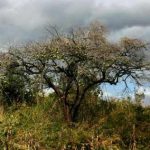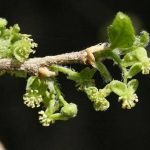TREE LIFE
August 2004
MASHONALAND CALENDAR
Saturday 7thAugust.
Garden Walk. Meet in the car park at 10.45 am for 11.00 am.
Sunday 15th August Our trip to the Dyke is postponed till later this year, so we have decided to return to one of our favourite venues, that is to Christon Bank. We will try to walk along the Mazowe River to be in the riverine vegetation, avoiding the gold panners if possible.
Bring a chair and your lunch and we will meet at 9.30 am.
Saturday 28th August. Mark’s walk will be at Greystone Park Nature Reserve .
Saturday 4th September. Tom will still be away but Meg Coates Palgrave or Mark will lead the walk.
MATABELELAND CALENDAR
Nothing has been arranged / for August.
Obituary: John Cottrill
We have just heard the sad news of the death of John Cottrill in England on April 29th, 2004. John was a keen member of the Tree Society and was also one of our trustees. We have the happiest memories of the interesting outings made by the Society to his home at Guitingwood.
The following is a short obituary written by his wife, Lilian.
John was born 1921 in Manchester. Joined the Territorial Army while at school and was called up for active service at the outbreak of war as a Second Lieutenant. Joined the Indian Army and served in India, Burma, Iraq and Iran. Achieved the rank of Major at 23 years of age. Developed an interest in waterlilies whilst in Burma. Was repatriated in 1945. Met me and married in 1946. Joined his brother in the stockbroking firm they had inherited from their father. Did not like the life or the Manchester weather so emigrated to Southern Rhodesia in 1950. Worked as a manager and then bought the farm, (Guitingwood). Built fish ponds, (and more and more fishponds!) mainly to grow waterlilies.
Had over 40 varieties at one stage. Developed a great interest in trees, made an arboretum and joined the Tree Society. Formed a great friendship with Rob Parre and learned a great deal from him. He loved the visits we had from the Tree Society and meeting all the people.
We were expelled from the farm in May 2002 and came to England in August to live in a two room, upstairs flat, having very little money. Not a single tree within a mile of us! John remained cheerful as ever and enjoyed giving talks about Zimbabwe to various groups.
He filled in his time by writing his memoirs and managed to complete them before he died. I don’t know if they will ever be published but there is one publisher who is interested and John had great pleasure in writing them and in reviewing his past, not uneventful, life.
He suffered a cerebral haemorrhage on April 4th and died on the 29th never complaining and still able to smile. What a good thing he did not live and be an invalid!
I heard recently from the Botanical Gardens that Clive Wakefield had rescued 32 waterlilies from Guitingwood and they were now giving pleasure to people at the Gardens. Perhaps they are a small memorial to John.
I can hardly believe I have written all that and not mentioned golf which really was a big part of his life but would perhaps not be of interest to readers of Tree Life.
In the many letters I have had from people they nearly all mention John’s love of nature and desire to pass it on to others and his optimistic cheerfulness. I do miss him!
–Much love. Lilian
BOTANIC GARDEN WALK: SATURDAY 5 JUNE 2004
Nine of us gathered in the car park of the Botanic Gardens on this Saturday morning. Meg Coates Palgrave kindly agreed to lead us and it was a pleasantly informal walk with no set subject and many contributions from others attending.
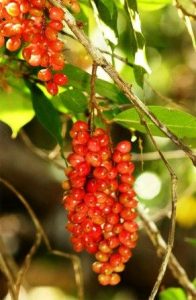
Antidesma venosum. Photo: Bart Wursten. Source: Flora of Zimbabwe
A plant of the Tassel berry (Antidesma venosum) bearing the tassels of berries caught our attention and someone mentioned that birds have a distinct order of preference based on colour as to which berries they will eat.
Most favoured are black berries, next red and purple and then with lower priority yellow and white and green. This presumably reflects the probability of the berry being ripe, with a black one the most likely and a green berry probably the least likely. It is a bit unsatisfactory though for trees whose ripe berries are white.
Dalbergia melanoxylon was seen growing next to and somewhat tangled up with Ormocarpum zambesiacum, and superficially the leaves looked somewhat similar
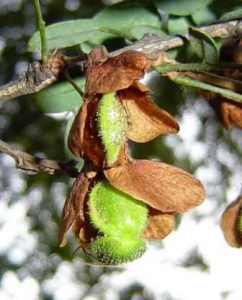
Ormocarpum zambesiacum. Photo: Bart Wursten. Source: Flora of Zimbabwe
both are 1-pinnate. However, the fruits of each were both present and are very different: the Dalbergia has a flattened pod with wings on the margins whereas the Ormocarpum has strongly segmented hairy fruits. The ormocarpum, although it has been known for many years, has only recently been described.
Gardenia volkensii, like many other gardenias, has its leaves and often its branches in whorls of 3. It’s known as the Mercedes Benz tree because the twigs in 3s slightly resemble the famous car’s symbol. This particular tree was bearing fruit enabling us to see the inferior ovary characteristic of the family Rubiaceae.
Meg mentioned an interesting thing about Croton gratissimus. This species produces buds during the rainy season (c. February) and these buds sit on the tree throughout the dry season and only open when the next season starts.
We also looked at Bivinia jalbertii. The petioles, like those of many Flacourtiaceae, are often red (not obviously so in this case); the tree trunk is a straight erect pole and the branches are held in flat planes. It’s a distinctive and quite attractive species, increasingly planted around Harare.
It was an interesting session which I enjoyed very much. I would like to thank Meg for a stimulating walk.
-Mark Hyde
INDIGENOUS TREES IN FLOWER IN THE GARDEN ALL THE YEAR ROUND. (Continued)
Breaking away from yellow two very spectacular flowering trees at the other end of the spectrum are the wild-wisteria, Bolusanthus speciosus and the violet tree Securidaca longepedunculata. According to Trevor Gordon the wild-wisteria flowers between 15th September and 15thOctober. It certainly is spectacular in full flower, before or with the young leaves. The flowers are pea-shaped, blue to mauve in loose sprays up to 30 cm long at the ends of the branches. I remember coming back from South Africa in early October and seeing them dotted about on the side of the road and into the distance just before the Shell Garage outside Masvingo They seem to occur naturally at a slightly lower altitudes than Harare. It belongs to the pea family so presumably the seeds are quite easy to germinate. I grew one once having bought a seedling but although I had it for 12 years it never flowered. I think they need full sun and mine was in too much shade.
In the same garden I had a violet tree, but that was there, I had not planted it. That is also a spectacular sight and with a wonderful scent. And the picked flowers last well in water, up to two weeks and retain their scent for much of the time. I think they usually flower towards the end of October and into November. These can be tricky to grow from seed. First of all I think the seed should be put where the tree is intended to grow. Probably root disturbance is fatal. Eileen McBean used to say the seed should be put where the tree is to grow and covered with a cow pat, not any sort of cow pat, a jersey cow pat. She kept a couple jersey cows on her small holding and germinated wild-violet seeds very successfully.
In July we are given hope that winter is nearly over with the red flowers of the red-hot-poker tree, Erythrina abyssinica. Being red the flowers are probably pollinated by birds. This is one of the luckybean trees. And I must just mention Erythrina lysistemon the sacred coral-tree as we are now calling it. It was decided that would be a good name because there is a tradition that when a man dies a truncheon should be taken from a tree near his home and planted on his grave. And why must I mention it. Once upon a time long ago and far away my father bought London Farm at Nyanga. He built London Garage which he did not run and he built London Store which my mother ran and which probably provided some sort of an income until the farm was able to do so. He also built a stone house next to a circle of trees which became the garden. Once it had been one of Rhodes outspan spots when he visited his estate at Nyanga. That circle of trees consisted of the sacred coral-tree and the common wild fig, I’ll come on to figs in a minute.
When Paul and I were married in in September, 1957 at London Farm, my bouquet consisted of flowers of sacred coral tree and Dombeya rotundifolia, wild-pear, which we collected and arranged ourselves. My sister took care of all the wedding superstitions for us and added three little yellow primroses from the garden. The flowers of the wild-pear are interesting in that unlike most flowers when they have been pollinated the petals do not fade or drop but remain on the flower to become dry and papery and function as wings to distribute the seed. That explains why they are so white to start with and then become dull and drab.
For March also with white flowers is the cluster-head protea, Protea welwitschii but what pollinates them is a good question. In Zimbabwe this species can be confused with the African protea, Protea gaguedi, but is distinguished by its unusual habit of producing 2-4 flowerheads together, and the fact that its old flowerheads open out flat when the seeds are shed, whereas those of the African protea remain cup-shaped. They flower before Christmas. The leaves of the African protea are mostly hairless, or sometimes slightly hairy when young, whereas those of the cluster-head protea start off densely furry and even the older leaves have hairs, at least near the base. Our three common proteas are actually easy to distinguish between by when they flower. The northern protea, Protea angolensis comes into flower after the rains are over about June and July. That has broad leaves that are bluish green and hairless.
So what do we have
January – monkeybread
February large-leaf acacia
March – cluster-head protea
April – indaba tree fruit, common wild fig
May – confetti-tree
June – winter senna, northern protea
July – red-hot-poker tree
August – worm-cure albizia, sausage-tree
September – mukwa, sacred coraltree, wild-pear
October – wild-wisteria and violet-tree;
October/November poison-pod albizia
November – baobab, african-wattle, african protea
December – round-leaved bloodwood
The month that does not seem to have anything is April so I am going to put figs in there.
A fig is called a synconium, syn – with, konos – cone, defined as the hollow inflorescence axis of the fig, or as I would describe it, a receptacle, which has folded over, closed and become hollow with the flowers round the inside. If the flowers are enclosed inside a hollow, how are they pollinated? They are pollinated by tiny members of the wasp family. When I say tiny I mean tiny. One of our indigenous fig trees with quite a large figs is Ficus sur. The wasp that pollinates those figs is no more than 2 mm long. As a reward for pollinating the flowers of the fig the wasps are provided with a haven in which their young can be raised. This is a case of a real symbiotic relationship.
At the end of the fig, opposite the stalk, is an opening called the ostiole. This is covered by scales placed in such a way that it is impossible for anything to get out and very difficult for anything to get in. Only the pollinating wasp has enough determination to do so and often loses parts of her wings and legs in the process. The pollen was carefully tucked away in her pollen sacs and so is quite safe.
Having gained entry, the little female wasp then takes the pollen from her pollen sack and deliberately pollinates the female flowers of the fig. Not only does she pollinate the flowers, but she also she lays her eggs. Some flowers are intended to produce seed and have long styles. These are solid, preventing the wasp from laying an egg in them. Some flowers have short styles with an open canal so that the wasp can get her ovipositor into the ovules and lay an egg. So the tree has made provision both for it’s pollinator and for itself to develop seeds.
When she lays the eggs, those flowers are stimulated to react by developing an abnormal growth, or gall, around them. This provides food for the forthcoming young. Then follows the normal life-cycle of an insect. The egg hatches into a larva, which having eaten enough, pupates and eventually the adults emerge.
The first ones to do so are the little males. They are wingless, eyeless and have very reduced legs, but are much more robust than the females and, although they aren’t going anywhere, they do have an important role to play. They identify the pupae containing the female wasps, which they open and then mate with the females. They have another very important function. The males all get together and bore a hole through the fig wall into the outside world. The theory being that the fig is full of carbon dioxide and they need fresh air.
The atmospheric oxygen stimulates the females to rouse themselves. The first thing they do is visit the male flowers of the fig, now mature and full of pollen. The female wasps deliberately fill their pollen sacs with pollen, make their way though the hole that the males have made to the outside world, fly off to find another fig tree of the same species. Each species of Ficus has it’s own species of pollinating wasp.
The figs, as a fruit, do not ripen until about five days after they have had a hole made and the oxygen let in allowing for the development of ethylene. So they do not get eaten until after the pollinators have flown away. However, not everything is simple survival for the fig pollinating wasps, because for every species of pollinating wasp there are often a number of wasps that parasitise them. The parasitising wasp lays her eggs through the wall of the fig into the flower with a pollinating wasp larva, but she must not lay too many eggs otherwise there will be not be enough males of the pollinating wasp to let them out of their potential tomb.
The trees that are called sycamore in England, which are different from the trees that are called sycamore in America, do not occur in Biblical areas. So the reference in the Bible, to the sycomore that Zacchias climbed, was probably Ficus sycomorus. These become large trees with a yellowish bark and the almost horizontal branches bear the figs which do actually taste quite nice. But the interesting thing is, that the pollinating wasp of the sycomore fig does not occur in Biblical areas. So the sycomore trees must have been introduced from Africa, either as cuttings, or seedlings, or they may even have been grown from the seed of the figs that had been imported. As there are no pollinating wasps, holes are not made in the figs and so they don’t ripen, naturally.
There is the story of Amos, who said he was not a prophet but as a simple shepherd and dresser of figs. What did he mean? If you owned a sycomore fig you would want the figs to ripen and if you were wealthy you could afford to employ someone to make holes in the figs to ripen them. And if you were a shepherd you would be able to sit on the branch of a sycomore fig, keeping an eye on your sheep and earning a few extra bucks nipping figs. Do not let anyone tell you that figs are pollinated by ants again. The ants only get in afterwards!
-Meg Coates Palgrave
DARWENDALE: SUNDAY, JUNE 20TH, 2004
Our 3rd Sunday outing was to the home of Helen and Albert Gray at Lake Manyame Park near Darwendale. A warm welcome awaited us with tea, cakes and snacks served to us on a rooftop in the wintry sunshine. The turnout was good and the temperatures just slightly higher than the Harare chill adding to the warmth of the occasion.
Today was also the first day of an experiment for the Tree Society. The Committee felt that not enough emphasis was being given to beginners. It is difficult to lead a group and cater to people who are just staring as well as satisfying the more advanced people. It had therefore been decided to split the party into two groups: one for beginners, led by Rob Burrett, and the other for the more advanced, led by me.
This idea is somewhat similar to the “Ten Tree group” idea which Dick Hicks initiated in which the starters’ group would study 10 trees and no more so as to avoid the terrible Latin-name indigestion which can occur on our outings.
The two parties moved off into slightly different areas. All around the house was the leguminous miombo woodland typical of much of Zimbabwe. The altitude, according to my GPS, was 1370 metres, definitely lower than Harare. As one often sees, Brachystegia boehmii (mufuti) was the commonest Brachystegia at these altitudes and in fact, no msasa (Brachystegia spiciformis) was seen near to the house. Also accompanying the mufuti was the ubiquitous Julbernardia globiflora (the mnondo).
All these legumes were in fruit and, of course, leaf, and in the early stages of the walk we quickly revised the distinctions between these common species.
In effect, we then spent the morning walking round the house; it was typical of the Tree Society that so little physical distance was covered but we did have an excuse. Not only did we look at almost everything, we also named the species so that Albert could label the trees for future reference.
Some of the more interesting trees seen were as follows. In winter, species of Vernonia are quite frequently seen in flower; these belong to the Asteraceae, the daisy or sunflower family in which groups of tiny similar small flowers (florets) are grouped in heads so as, in some cases, to mimic one giant flower head.
Mostly the family consists of herbaceous species but a few taxa are woody, namely, with us, Vernonia, Brachylaena and Tarchonanthus.
Two of the commonest woody vernonias are Vernonia colorata and Vernonia amygdalina. These are mostly large shrubs rather than true trees, although they can be trees on occasion. Both are superficially similar and I must admit that I cannot tell them apart at a glance. However, if the mature ovary or achene is examined under a lens, the two can readily be separated: V. colorata has spherical gland-like structures only whereas V. amygdalina has these and hairs as well.
V. amygdalina appears to be the common one around Harare, whereas V. colorata comes in in drier sites at lower altitudes, as indeed was the case here at Darwendale.
Another species seen was Bauhinia petersiana subsp. petersiana, which is the white-flowered species, seen commonly in areas north of Harare. This is usually a shrub but has definite climbing tendencies and occasionally the branches may be seen to coil in a tendril-like fashion.
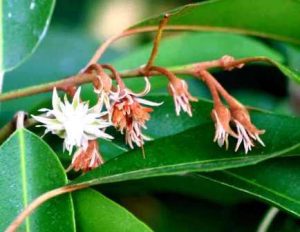
Mimusops zeyheri . Photo: Bart Wursten. Source: Flora of Zimbabwe
Two trees in the Sapotaceae were also observed. Both of these, namely Mimusops zeyheri and Englerophytum magalismontanum have glossy dark green leaves and milky sap. However, the shape of the leaves is different, the Englerophytum has obovate or oblanceolate leaves and the leaves have a noticeably silvery underside.
After lunch, we set off to a slightly different area across the road to Trudy Cashel’s property. The vegetation here consisted of dry rocky woodland on a slope with plenty of grass among the trees and many rocks. Here was msasa as well as Brachystegia boehmii and that typically rocky species, Brachystegia glaucescens.
Here too was Strychnos innocua, the species with the powdery bark. Olax dissitiflora was also seen and on crushing the leaves the typical almond smell was (reluctantly) produced. Some specimens of Euclea natalensis were found which were relatively large and tree-like. One specimen of Commiphora mossambicensis was also seen.
Herbs in the woodland consisted of the stout composite Inula glomerata and the very common sprawling white-flowered Hypoestaes forskaohlii.
After a time we emerged on to a track and a few new species were seen: Acacia goetzei, Pterocarpus rotundifolius and Albizia amara.
All in all, it was a very enjoyable day. The concept of splitting into two groups was a resounding success and I expect that we will be doing this quite regularly, at least when two leaders are available.
Our grateful thanks go to the Grays for welcoming us to their home and providing us with such magnificent hospitality.
-Mark Hyde
As Anne Mullin has emigrated to UK, Lyn’s book Historic Trees of Zimbabwe will be available from Maureen Silva-Jones – while stocks last of course.
In Retrospect – Lyn Mullin
A CRY FROM THE EARTH
The gem below was published in TREE LIFE No.137 (July 1991) under the title “Roll-call of the Assembled Beings – From the Soil:
I am the Living Earth. I am the softened tissue of rocks; baked by the sun, split by ice, carved by water, and winnowed by the wind. I am interwoven by myriads of tiny plants and animals that pulse and breathe. I am the invisible universe of sparkling molecules in the infinity of living soils that bless the mantle of the globe.
I am the carpet of the biosphere, the floor of the forest, the seed bed of all plants; and my living substance nourishes all roots and all leaves that rely on the sun and rain to make green sculptures out of clay. In the tall dim damp rainforests I house the bulk of animal life, and support the endless upwards toiling of trees and coiling of vines. I am the bottom line of all grand symbiosis in forest biology. I am the source of mineral molecules in lovely flowers born high among the birds in the forest canopy. I am the energy sink, the lovely muddy frugal cemetery for recycling all the forests’ elements in the transitions between life and death.
Touch me, smell me, I am your ultimate quality of life in ecology’s profound cycles. See me, hear me, you humans who pass me by with your round computer heads rocking in the forest sky above me. Spare me a thought, you humans who depend on me; remember me, as I die before you, when you take away my forest coverings and still the microbes that give me life, me the Living Earth.
Shift your gaze sometimes from the stars and remember the heaven beneath your feet. Remember me when the sun burns and the waters gouge me, be kind to the forests that remain, and protect them from senseless cuttings. Remember: like me, you are already eroding. Know this: like me, you are only dust when you are dead. Accept this: unlike you, I am closer to re-creation as the living earth, to genesis. (Len Webb 9.2.89)
MARK HYDE CHAIRMAN


